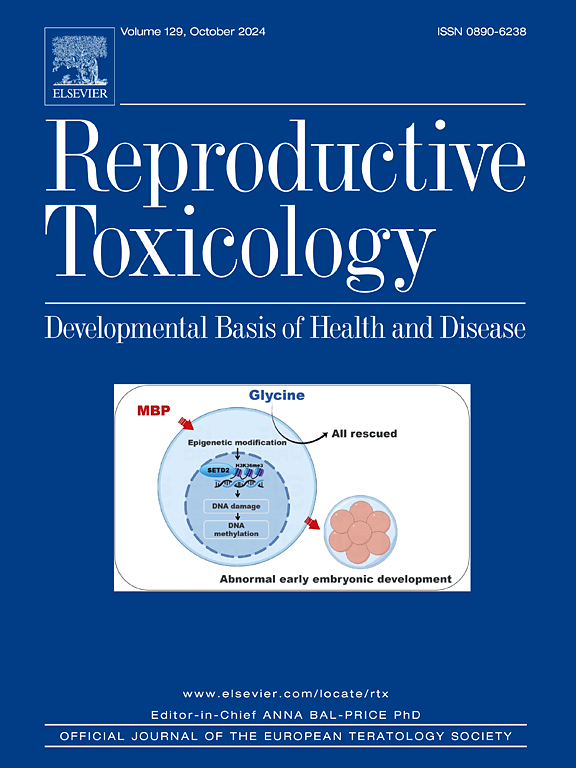Folate deficiency mediates ovarian dysfunction through appetite and inflammatory pathways
IF 2.8
4区 医学
Q2 REPRODUCTIVE BIOLOGY
引用次数: 0
Abstract
The long-established link between nutrition and reproduction is known to have critical consequences for reproductive function. However, the available experimental data on the effects of folate deficiency on ovarian health remains scarce. It is still unclear whether folate deficiency is directly responsible for causing ovarian-dysfunction and, if so, what are the underlying mechanisms. Therefore, our objective was to establish evidence for association between folate deficiency, hormone dynamics, and ovarian function using in vivo model. Folate-deprived female zebrafish were developed using intraperitoneal administration of methotrexate (MTX; DHFR inhibitor) and were used to study the possible implications of folate deprivation on ovarian health. Changes in the expression of transcripts regulating appetite and ovarian function was observed. We observed that folate deprivation resulted in impaired appetite behaviour and alteration in its regulatory gene expression. Due to folate deficiency, the neuroendocrine function of the brain was affected that resulted in altered reproductive hormone levels. Histology of ovary shows follicles arrested in primary oocyte stage and scarring of tissue is seen. Furthermore, elevated lipid peroxidation and catalase enzyme activity along with increased IL-6, indicates folate deficiency induced oxidative stress and inflammation in ovary as one of the possible mechanisms to aid- ovarian dysfunction. Our study provides experimental evidence, using an in vivo folate-deficient fish model, that underscores the essential role of folate in maintaining reproductive health. The intricate relationship between folate deficiency, appetite regulation, and its impact on the synthesis and release of female reproductive hormones calls for deeper investigation, particularly through studies involving mammalian models.
叶酸缺乏通过食欲和炎症途径介导卵巢功能障碍
长期以来,营养与生殖之间的联系被认为对生殖功能有重要影响。然而,关于叶酸缺乏对卵巢健康影响的现有实验数据仍然很少。目前尚不清楚叶酸缺乏是否直接导致卵巢功能障碍,如果是,潜在的机制是什么。因此,我们的目标是利用体内模型建立叶酸缺乏、激素动态和卵巢功能之间关联的证据。通过腹腔注射甲氨蝶呤(MTX)培养叶酸缺乏的雌性斑马鱼;并用于研究叶酸剥夺对卵巢健康的可能影响。观察到调节食欲和卵巢功能的转录本表达的变化。我们观察到叶酸剥夺导致食欲行为受损及其调控基因表达的改变。由于叶酸缺乏,大脑的神经内分泌功能受到影响,导致生殖激素水平改变。卵巢组织学显示卵泡在初级卵母细胞期停止,组织瘢痕形成。此外,脂质过氧化和过氧化氢酶活性的升高以及IL-6的升高表明叶酸缺乏引起卵巢氧化应激和炎症是导致卵巢功能障碍的可能机制之一。我们的研究提供了实验证据,使用体内叶酸缺乏的鱼类模型,强调叶酸在维持生殖健康中的重要作用。叶酸缺乏、食欲调节及其对雌性生殖激素合成和释放的影响之间的复杂关系需要更深入的研究,特别是通过涉及哺乳动物模型的研究。
本文章由计算机程序翻译,如有差异,请以英文原文为准。
求助全文
约1分钟内获得全文
求助全文
来源期刊

Reproductive toxicology
生物-毒理学
CiteScore
6.50
自引率
3.00%
发文量
131
审稿时长
45 days
期刊介绍:
Drawing from a large number of disciplines, Reproductive Toxicology publishes timely, original research on the influence of chemical and physical agents on reproduction. Written by and for obstetricians, pediatricians, embryologists, teratologists, geneticists, toxicologists, andrologists, and others interested in detecting potential reproductive hazards, the journal is a forum for communication among researchers and practitioners. Articles focus on the application of in vitro, animal and clinical research to the practice of clinical medicine.
All aspects of reproduction are within the scope of Reproductive Toxicology, including the formation and maturation of male and female gametes, sexual function, the events surrounding the fusion of gametes and the development of the fertilized ovum, nourishment and transport of the conceptus within the genital tract, implantation, embryogenesis, intrauterine growth, placentation and placental function, parturition, lactation and neonatal survival. Adverse reproductive effects in males will be considered as significant as adverse effects occurring in females. To provide a balanced presentation of approaches, equal emphasis will be given to clinical and animal or in vitro work. Typical end points that will be studied by contributors include infertility, sexual dysfunction, spontaneous abortion, malformations, abnormal histogenesis, stillbirth, intrauterine growth retardation, prematurity, behavioral abnormalities, and perinatal mortality.
 求助内容:
求助内容: 应助结果提醒方式:
应助结果提醒方式:


